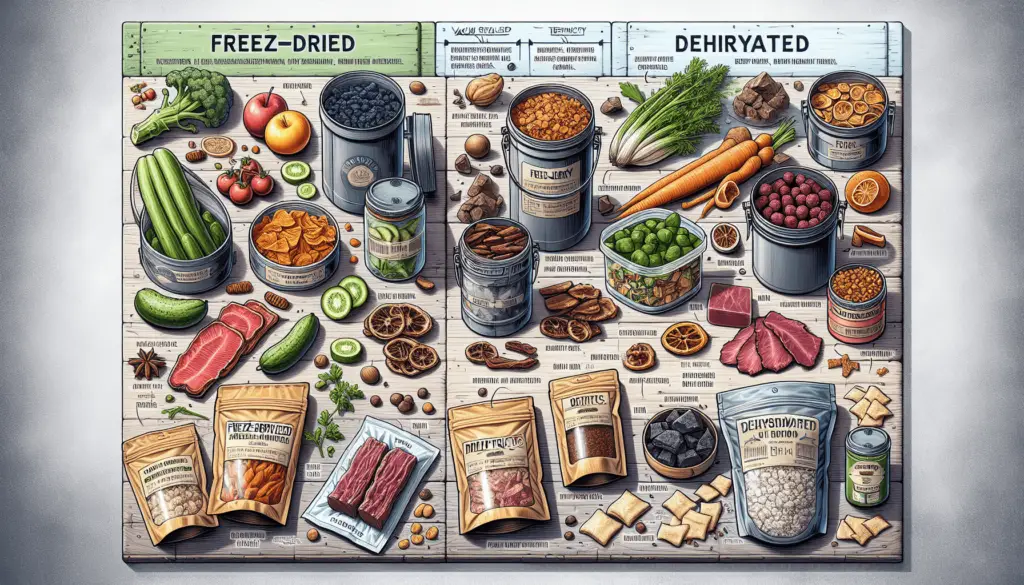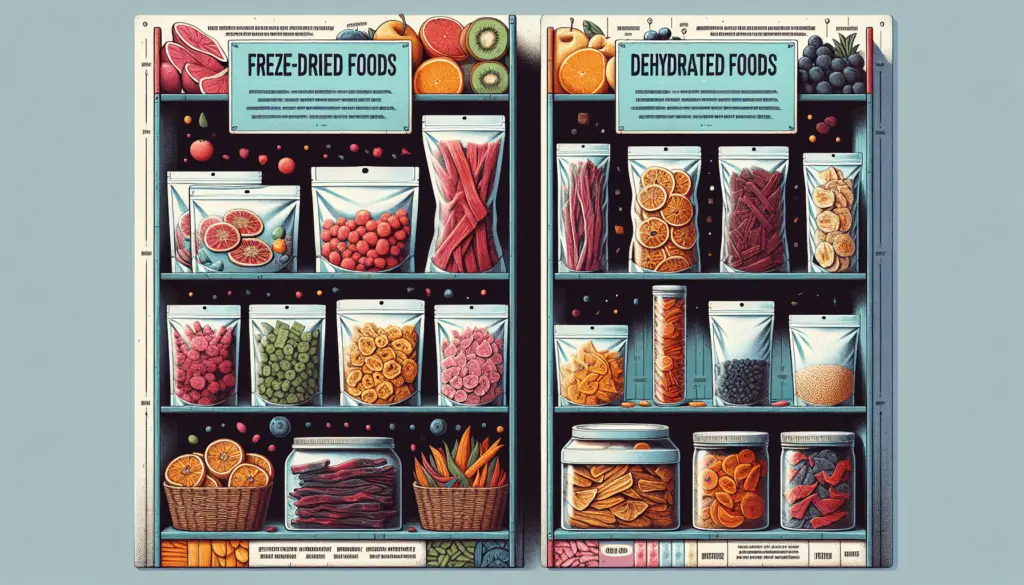In this article, we will explore the differences between freeze-dried foods and dehydrated foods, focusing specifically on their effectiveness for long-term storage purposes. Both methods are commonly used to preserve food, but understanding the distinctions between them can help you make informed decisions for your own food storage needs. So, let’s dive into the world of freeze-dried and dehydrated foods and discover which ones come out on top for long-term storage!
Definition
Freeze-Dried Foods
Freeze-dried foods are a type of food preservation method that involves removing the moisture from the food through a process called sublimation. In this process, the food is frozen and then placed in a vacuum chamber where the ice crystals convert directly from a solid to a gas, bypassing the liquid stage. This results in a product that is lightweight, retains its shape, and has a long shelf life.
Dehydrated Foods
Dehydrated foods, on the other hand, are preserved by removing the water content from the food through evaporation. The food is typically heated, which causes the water to evaporate, leaving behind a dehydrated product. Unlike freeze-dried foods, dehydrated foods do not undergo sublimation and therefore have a different texture and taste.
Method
Freeze-Dried Foods
The process of freeze-drying food involves several steps. First, the food is frozen, usually by quick freezing. Then, it is placed in a vacuum chamber where the pressure is reduced, and heat is applied. The frozen water in the food turns into gas and is removed from the chamber, leaving behind a freeze-dried product. This method helps to retain the original shape, texture, and taste of the food.
Dehydrated Foods
Dehydration is a simpler process compared to freeze-drying. The food is heated to remove the water content, either through sun-drying, air-drying, or using a dehydrator. The heat causes the water to evaporate, resulting in a dehydrated product. While this method is less complex than freeze-drying, it can cause some loss of flavor, texture, and nutrients in the food.

Nutritional Value
Freeze-Dried Foods
Freeze-dried foods are known for their ability to retain the nutritional value of the original food. Because the freeze-drying process involves removing moisture without high heat, the vitamins, minerals, and other nutrients remain intact. This makes freeze-dried foods a great option for those looking for a lightweight, long-lasting food source with high nutritional value.
Dehydrated Foods
While dehydrated foods also retain some nutritional value, the dehydration process can cause a loss of certain vitamins and minerals. The heat involved in the dehydration process can break down some of the nutrients, leading to a decrease in nutritional content. However, dehydrated foods still provide essential nutrients and can be a good source of energy in a long-term storage scenario.
Shelf Life
Freeze-Dried Foods
One of the major advantages of freeze-dried foods is their exceptionally long shelf life. Due to the low moisture content, freeze-dried foods can typically be stored for 25 to 30 years or even longer if kept in suitable conditions. This makes them an excellent option for emergency preparedness, outdoor activities, or situations where long-term storage is necessary.
Dehydrated Foods
While dehydrated foods also have a long shelf life, they are not as durable as freeze-dried foods. Dehydrated foods can typically be stored for 5 to 10 years when stored in a cool, dry place. However, factors such as temperature and moisture can affect their shelf life. It’s important to rotate dehydrated food supplies to ensure freshness and maximize their shelf life.

Texture and Taste
Freeze-Dried Foods
Freeze-dried foods maintain their original texture and taste to a remarkable degree. The sublimation process preserves the structure of the food, resulting in a product that closely resembles its fresh counterpart when rehydrated. Whether it’s fruits, vegetables, or meat, freeze-dried foods offer a satisfying crunch and flavor that makes them enjoyable to consume.
Dehydrated Foods
Dehydrated foods, on the other hand, tend to have a different texture and taste compared to their fresh counterparts. The removal of water can cause dehydrated foods to become dry and tough, making them more suitable for use in soups, stews, or as ingredients in other dishes. While the flavor of dehydrated foods may differ slightly from the fresh version, they can still be delicious and nutritious when properly prepared.
Preparation and Rehydration
Freeze-Dried Foods
Preparing freeze-dried foods is incredibly easy and convenient. Most freeze-dried foods simply require the addition of hot water to rehydrate them. The process is quick, often taking just a few minutes, and the result is a ready-to-eat meal or ingredient that can be enjoyed directly or included in various recipes. This makes freeze-dried foods an excellent option for camping, hiking, or any situation where quick and simple meal preparation is desired.
Dehydrated Foods
Rehydrating dehydrated foods requires a bit more time and effort compared to freeze-dried foods. Depending on the type of food, it may need to be soaked in water for a longer period or simmered in liquid to fully rehydrate. The time required to rehydrate dehydrated foods can vary, but with proper planning and preparation, they can be transformed into delicious meals or snacks.
Storage Space
Freeze-Dried Foods
Freeze-dried foods excel in terms of storage space. The removal of water during the freeze-drying process significantly reduces the size and weight of the food, allowing for compact storage. This is particularly beneficial in situations where space is limited, such as backpacking or emergency kits. Whether it’s individual pouches or larger containers, freeze-dried foods can be neatly stacked and stored without taking up much room.
Dehydrated Foods
Dehydrated foods, although not as space-efficient as freeze-dried foods, still offer advantages in terms of storage space. The removal of water reduces the overall bulk of the food, making it more manageable to store. Dehydrated foods can be stored in airtight containers or vacuum-sealed bags, saving space and keeping the food fresh for an extended period. However, it’s important to consider the potential need for extra storage space due to the larger size compared to freeze-dried foods.
Availability and Cost
Freeze-Dried Foods
Freeze-dried foods are widely available and can be purchased from various retailers, both online and in physical stores. There is a wide range of options available, including single-ingredient pouches, pre-packaged meals, and even bulk containers. While the cost of freeze-dried foods can be higher compared to other food options, their long shelf life and convenience make them a worthwhile investment for those seeking reliable long-term storage solutions.
Dehydrated Foods
Dehydrated foods are also readily available and can be found in many stores or easily made at home using a dehydrator. They can be purchased in bulk or as individual ingredients, allowing for greater flexibility in meal planning. Dehydrated foods tend to be more cost-effective than freeze-dried foods, making them a practical choice for those looking for affordable long-term storage options.
Application
Freeze-Dried Foods
Freeze-dried foods have a wide range of applications. They are popular among outdoor enthusiasts, campers, and hikers due to their lightweight nature and easy preparation. Freeze-dried foods can also be used as emergency food supplies, ensuring that you have nutritious meals available during unexpected situations. Additionally, they are often used in the military, space missions, and scientific research where lightweight, long-lasting food options are essential.
Dehydrated Foods
Dehydrated foods are versatile and can be used in various culinary applications. They are commonly used in backpacking meals, homemade granola bars, trail mix, and other snacks. Dehydrated foods can also be incorporated into soups, stews, and casseroles, adding flavor, texture, and nutrients to the dishes. Their affordability and accessibility make them a popular choice for everyday cooking and long-term storage.
Conclusion
Both freeze-dried foods and dehydrated foods have their own advantages and applications. Freeze-dried foods excel in terms of nutritional value, texture, taste, shelf life, and space efficiency. They are a reliable option for long-term storage and emergency preparedness. Dehydrated foods are more cost-effective and offer versatility in their culinary uses. They may have slight differences in texture and taste, but they still provide essential nutrients and can be enjoyed in various dishes.
Ultimately, the choice between freeze-dried and dehydrated foods depends on individual preferences, needs, and circumstances. Whether you’re planning for an outdoor adventure, stocking up on emergency supplies, or simply looking for convenient meal options, both freeze-dried and dehydrated foods can play a valuable role in ensuring you have nutritious and delicious food available whenever you need it.
